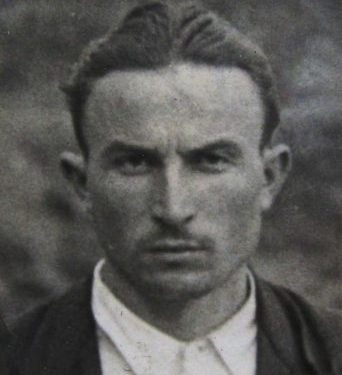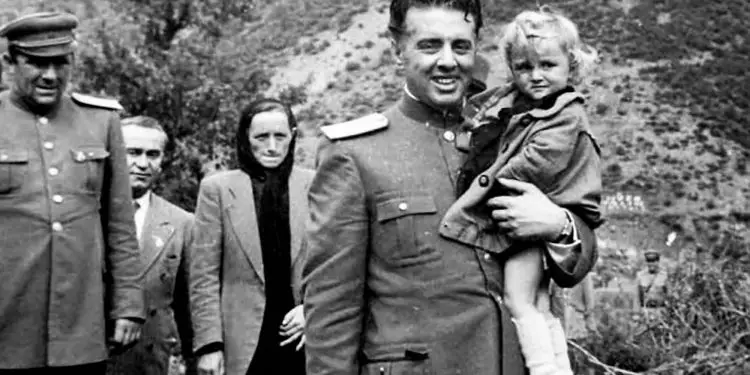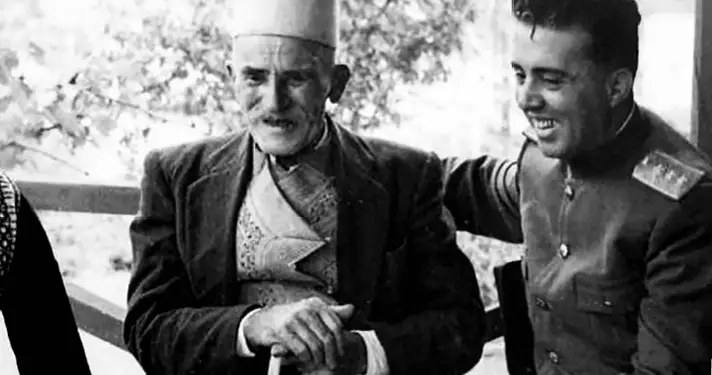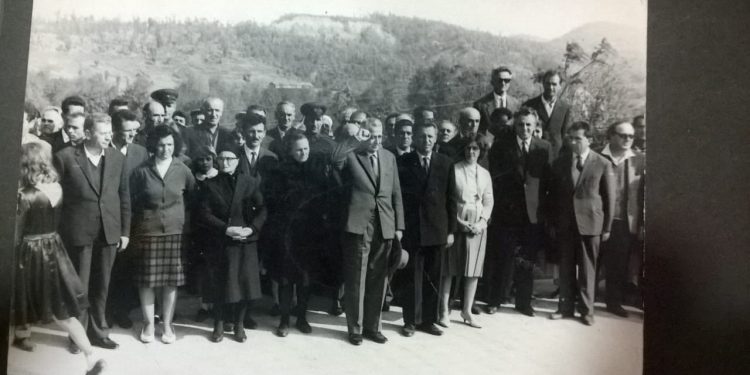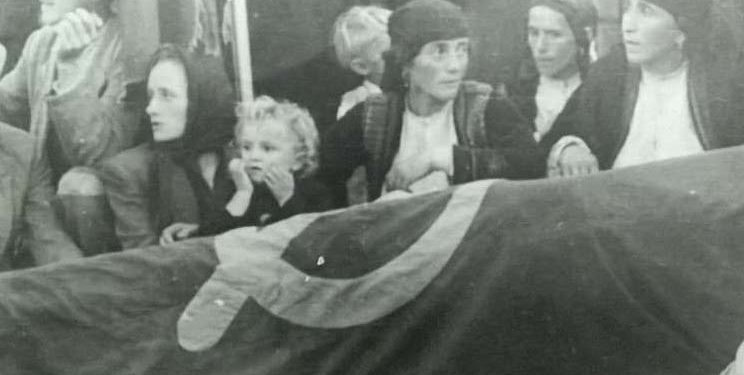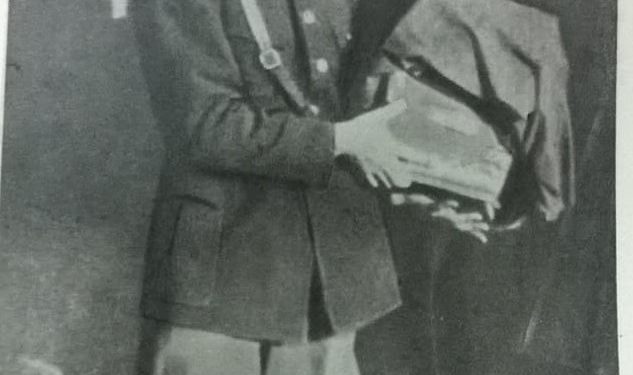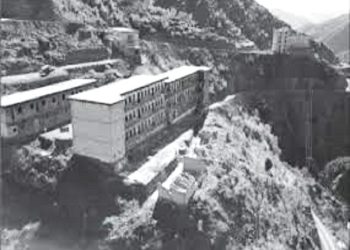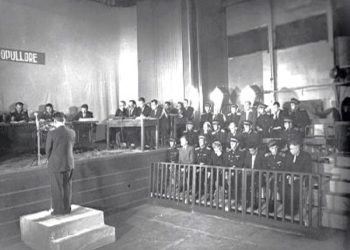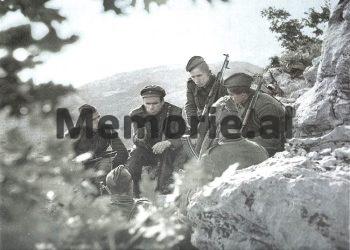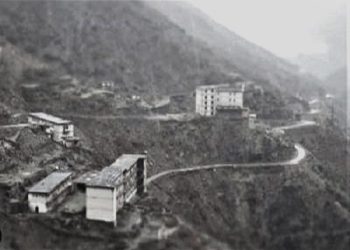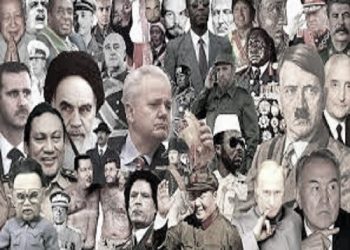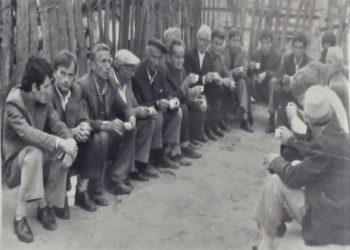By Gjergj Marku
Memorie.al / There is different evidence for the murder of Bardhok Biba. Ndue Pjetër Gjomarku himself declared in the office of former president Sali Berisha that: “We killed Bardhok Biba”. He labeled Bardhok Biba as the evil that planted communism in Mirdita, despite the fact that they were cousins from the same door (grandfathers are brothers). Later, it would be stated that; the signature on the letter of initiation, which was left in the bushes a few meters away from the lifeless body of MP Bardhok Biba, was that of the chairman of the “Mountain Committee” organization. Ndue Pjetë Gjomarku also wrote a book about this event, while he escaped, however everything remains a mystery, even the role he had in the murder of Bardhok Biba!
On the other hand, a contemporary of Bardhok Biba recounts the latter’s meeting with Mehmet Shehu. Mehmet Shehu asked him the question: “How many criminals have been annihilated in Mirdita”? “Comrade Mehmet, don’t think that they are cowards, they have gone to the mountains for their ideal, to die”, Bardhoku had told him. Later, in that meeting, he suggested to him the idea that he would work to bring back home those who did not have blood on their hands. His murder was fatal, as it would expose the entire Gjomarkaj tribe to various persecutions, as well as other Mirdita families, a tragedy that would divide Mirdita in two for 50 years.
In August of ’49, it snowed in Mirdita. Was the weather related to these murders? Figuratively yes, since it was a heavy blow to Mirdita, for both sides. The worst, they say. But had the murderers thought about the consequences? We think not, at their expense, since both the orderers and the executioners are either alive or have died in emigration. Someone else paid for it and took advantage of it. Political assassinations of important people have been constantly used to achieve the strategic goals of certain forces. Thus, August 17, 1949, was a very good opportunity for the government to finally extend its influence to Mirdita, carrying out an unprecedented terror.
However, all balanced Mirdita residents agree that the old trenches, the old weapons and the old people, who use the first two with the old skill, to divide the heroes and the victims into sides, must be abandoned. A humane step must be taken to respect both sides.
The murder of Bardhok Biba and the massacre of August 17
Mirdita- August 7, 1949, Qafë Valmiri. Three armed men were walking along the Kaçinari road, to descend down to the bank of Fani i Madh, and then uphill, to Shpal. A line of workers who had just been listed for work were following them. They were approaching a hilltop, when suddenly an extended battery of rifles spewed countless bullets from their muzzles, marked on one of them. Everything had been planned precisely. Two bullets had taken the life of the political secretary of the Communist Party of Mirdita, at the same time a deputy for this area, 29-year-old Bardhok Biba. The entire real mise-en-scène of a massacre, despite the communist regime, had come like a bolt from the blue, unthinkable by anyone.
The two companions, with two Karakatina rifles on their shoulders, were unable to do anything except the mountain ritual of arranging the corpse, placing both hands in the middle, according to custom. The assassins, after having looked closely and having been convinced that the “first of Mirdita” had given up the ghost, left a note in the bushes where they had ambushed him, with the inscription: “In the name of the Mountain Committee” and fled from there, to remain to this day, as a “collective symbol” of executioners, with all the facilities created by an “invisible” hand, to be exiled across the border.
Execution
The murder of Bardhok Biba was a heavy blow, among the heaviest that the newly installed communist regime was experiencing in the mountains of the North. Could “Tirana” swallow this? Many hypotheses have been put forward about what happened and what would happen next. Because, immediately after this murder, exactly the day after the funeral, the real tragedy would begin, which would engulf the whole of Mirdita? At the epicenter of the offensive of the units of the Persecution Forces, would now be placed not only the so-called “Mountain Committee”, which was thought to have its main bastion in Mirdita, but also families that were thought to have connections with the “reaction”!
Mirdita would turn into a real “gulag”. Its mountains would be created by the units of the Persecution, some of the most specialized in the country, while for entire families, lynching with all kinds of torture and persecution would begin. Even though 75 years have passed, this murder is still commented on by “two diametrically opposed camps”, and is used by politics, whenever anniversaries approach, a time when the injured “parties” show signs of reconciliation. Some connect it to the fact that Bardhok Biba himself was a vocal missionary of reconciliation in Mirdita and the North; others, to the fact that even the members of the families of those killed and later massacred were from the noblest families of Mirdita.
Who was Bardhok Biba and why was he killed?
Bardhok Biba was one of the suckers of the famous Gjomarkaj family in Orosh. A famous family, marked in history since the Austro-Turkish war of 1737-39, where one of this family was the commander of the Mirdita forces. Later, Bib Doda, also from this gate, was the first Christian Pasha, known by the Ottoman Empire, commander of an army of 10,000, “brigade general” after the Russian-Turkish war, on the banks of the Danube. The Pope also honored him with the Order of Saint Gregory; many countries, including France, established ties with Mirdita, thanks to the name of this famous gate.
The path of the general, who at that time gave his name to Mirdita, is followed by Preng Bib Doda, one of the “most enlightened and subtle” leaders of the North, as described in his memoirs by diplomat Eqrem Bey Vlora. Through war, diplomacy, fluid or stable alliances, the Gjomarkaj managed to preserve the unity of the Mirdita region, giving it a name that borders on legend, with the famous “Republic of Mirdita”. In this “door” with a voice, Bardhok Biba was born, in January 1920. He was educated in the Orosh boarding school, also established by the Gjomarkajs, and later in the Shkodra gymnasium.
There he came into contact with new ideas of the time, with Emin Duraku, Branko Kadina, Sadik Bektesh, Hajdar Dushi and the Kosovar Xheladin Hana. Influenced by these ideas and attitudes, he was expelled from school and, accompanied by gendarmes, was sent to Orosh. It was a time when he remained semi-illegal for some time, until he was involved in the vortex of the National Liberation War. After the liberation of the country, Bardhok Biba was elected deputy of Mirdita in the People’s Assembly, in 1947. On December 23, 1948, he was appointed Political Secretary of the Communist Party of Mirdita.
It is the period when he deals extensively with poor Mirdita, scouting new cities and development strategies, while before ’44, he had managed to create the possibility of forgiving over 500 blood feuds through a unique blood feud reconciliation assembly, reducing this fratricide phenomenon in this region. After 1944, only 3 cases of blood feuds are recorded in Mirdita. It was during one of the tasks he was carrying out in the area of Orosh and Kaçinar that he was planned to be executed by the “Mountain Committee”, who had declared open war on the regime that was also being established in Mirdita.
Two bullets, one in the chest and another in the ribs, would take his life, and shortly afterwards the People’s Assembly would grant him the title of “Hero of the People”. For nearly 41 years, Bardhok Biba would remain a symbol of Mirdita, until after this year, his bust that of Pal Mëlyshi, Ndrecë Ndue Gjokë or the four Heroines, would be erased from the face of the earth, while the day of commemoration of their fall would gather the Mirdita people always divided in two.
Revenge on Mirdita
On August 9, 1949, just two days after the murder of Bardhok Biba, by order from above, one of the most infamous offensives was prepared, which would target not only Bardhok Biba’s assassins, but all of Mirdita. A brigade specialized in pursuing gangs, under the command of Colonel Zija Kambo, entered Mirdita at night. Over 300 were arrested within a few hours. Around 300 families were gathered and their internment in Tepelena was decided. Most of the prisoners were sent to Shkodra or elsewhere. After the screening, 26 of the arrested are scheduled to appear in court. Of the 20 defendants, for whom the prosecutor requested the death penalty, the court decides; 4 to be hanged and 10 others to be shot.
The execution of the decision was to take place in Qafë Valmir, exactly where Bardhok Biba was killed. The population had been notified, so that they could see the scene of the executions with their own eyes! After they were taken to the place where a large pit had been dug, they began the execution in front of the people present there, killing them one by one. Then they threw them into the pit, and anyone who did not die with the first bullet was covered alive in the earth with a prayer to shoot him. According to witnesses, the weather after all this carnage was terrible, the snow that fell all night is said to have fallen with a reddish color. Those shot, according to witnesses, had no connection to the murder of Bardhok Biba. They were carefully selected from respected and influential families in the Mirdita bajraqs.
The absurdity of these shootings went so far that when the listed name was not found at home, the brother was taken and shot. Pregnant women who had given birth in internment camps were also interned. According to researchers, the murder of Bardhok Biba continues to be seen in black and white to this day. To this day, the figure of Bardhok Biba has been more associated with the communist ideal than with the human one, because he was first a fighter for the new, social emancipation, and then a partisan fighter. He was the man who implemented the giving of allegiance, the taking of allegiance and, even, the forgiveness of the blood of his brother, for greater interests.
His figure should be treated as a historical figure with a real contribution, in the most difficult times of Mirdita. On the other hand, researchers add that; Bardhok Biba was killed, among other things, because with the new mentality, he was competing with the values of the old aristocracy, he was killed because he was overshadowing the legacy of his door, which had established authority, through attributes that were already surpassed and inheritance. The door of the kapedans had expanded so much that the emergence of a “kapidan” outside their influence could not be tolerated.
The executed of August 17, 1949
On the evening of August 17, two types of executions were carried out. Four of them by hanging and 10 by execution by firing squad.
The hanged:
- Preng Ded Kola, Orosh.
- Pjetër D. Vila, Kaçinar.
- Dodë Mark Biba, Kthellë Epër.
- Pjetër Paloka, Kaçinar.
Shooted:
- Nikollë Bardhok Bajraktari, Rrëshen.
- Llesh Gjon Melyshi, Malaj.
- Nikoll Llesh Bajraktari, Orosh.
- Ndrecë Mark Ndoj, Kaçinar.
- Bardhok Dodë Gjini, Prosek.
- Gjok Gjin Kaçi, Bukmirë.
- Gjergj Beleshi, Kthellë Epër, is killed for his brother, Dodë.
- Ndoc Gjet Çupi, Blinisht.
- Preng Shkurt Nikolli, Orosh.
- Frrok Mata, Kaçinar.
The Qafë-Valmir massacre is denounced after the ’90s
The macabre murder, the collective burial and the way in which 14 Mirditë men were executed, on the pretext that they were directly or indirectly connected to the “Mountain Committee”, was denounced after the ’90s. The relatives of the 14 martyrs filed their criminal complaint against the executioners in Qafë Valmiri with the prosecutor’s office in 1994.
The complaint was addressed to three people who were alive and who had directly participated in the execution of the 14 martyrs, to the former head of the Mirdita Internal Affairs Branch, an exponent of the former State Security and the former head of the Mirdita Executive Committee.
At the core of the complaint was the accusation of exceeding the legal powers of the time, a legal nonsense, as defined in the complaint? A day later, the complaint was published in the right-wing newspapers of the time. The former head of the Mirdita Internal Affairs Branch, as soon as he learned of the signing of the arrest warrant, died at home, while the other two were arrested and sent to Rrëshen. / Memorie.al




